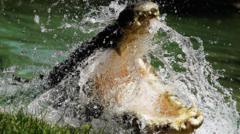As a ranger patrols the waterways of Darwin amidst heavy rains, the delicate balance between preserving Australia's largest reptile and ensuring the safety of its citizens becomes a pressing concern. Kelly Ewin, with two years on the job, finds himself in a fight against time, seeking to manage both the rising crocodile numbers and their interactions with humans. Despite the inherent dangers these territorial creatures pose—exemplified by a fatal incident last year—locals and authorities are working together to establish safer coexistence practices.
The region is grappling with increased crocodile encounters amidst their breeding season, prompting conversations on population control. The Northern Territory has escalated its annual culling limit from 300 to 1,200 crocodiles to safeguard residents while promoting educational outreach. The balance is further complicated by thriving tourism and luxury leather markets, which add economic incentive to manage crocodiles. Traditional owners of the land, like Otto Bulmaniya Campion, advocate for sharing benefits from sustainable practices, emphasizing their culture's historical connection to crocodiles. However, animal rights activists raise concerns about the ethics of crocodile farming.
With debates about conservation versus culling ongoing, the Northern Territory continues to navigate its relationship with these formidable predators. Whether through fostering community awareness or adjusting management strategies, finding a way to coexist with saltwater crocodiles remains essential for both safety and ecological integrity.





















